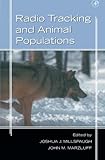Radio tracking and animal populations / edited by Joshua J. Millspaugh and John M. Marzluff
Millspaugh, Joshua J [editor] | Marzluff, John M [editor/a].
Tipo de material: Libro
impreso(a)
y electrónico
Editor: San Diego, California: Academic Press, c2001Descripción: xvii, 474 páginas : fotografías ; 24 centímetros.ISBN: 1493301608; 9781493301607.Tema(s): Radioseguimiento de animales
Libro
impreso(a)
y electrónico
Editor: San Diego, California: Academic Press, c2001Descripción: xvii, 474 páginas : fotografías ; 24 centímetros.ISBN: 1493301608; 9781493301607.Tema(s): Radioseguimiento de animales| Tipo de ítem | Biblioteca actual | Colección | Signatura | Estado | Fecha de vencimiento | Código de barras |
|---|---|---|---|---|---|---|
| Libros |
Biblioteca Campeche
Texto en la configuración de la biblioteca Campeche |
Acervo General | 591.5 R3 | Disponible | ECO040005929 | |
| Libros | Biblioteca Electrónica Recursos en línea (RE) | Acervo General | Recurso digital | ECO400539196943 |
Bibliografía e índice: páginas 423-474
Contributors.. Preface.. Part I: Introduction.. Chapter 1 - Historical and Practical Perspectives.. Part II: Experimental Design.. Chapter 2 - Experimental Design for Radiotelemetry Studies.. Chapter 3 - Effects of Tagging and Location Error in Wildlife Radiotelemetry Studies.. Part III: Equipment and Technology.. Chapter 4 - Recent Telemetry Technology.. Part IV: Animal Movements.. Chapter 5 - Analysis of Animal Space Use and Movements.. Chapter 6 - Fractal-Based Spatial Analysis of Radiotelemetry Data.. Chapter 7 - Estimating and Visualizing Movement Paths from Radio-Tracking Data.. Part V: Resource Selection.. Chapter 8 - Statistical Issues in Resource Selection Studies with Radio-Marked Animals.. Chapter 9 - Accounting for Variation in Resource Availability and Animal Behavior in Resource Selection Studies.. Chapter 10 - Using Euclidean Distances to Assess Nonrandom Habitat Use.. Chapter 11 - Effect of Sample Size on the Performance of Resource Selection Analyses... Chapter 12 - High-Tech Behavioral Ecology: Modeling the Distribution of Animal Activities to Better Understand Wildlife Space Use and Resource Selection.. Part VI: Population Demographics.. Chapter 13 - Population Estimation with Radio-Marked Animals.. Chapter 14 - Analysis of Survival Data from Radiotelemetry Studies.. Part VII: Concluding Remarks.. Chapter 15 - Radio-Tracking and Animal Populations: Past Trends and Future Needs.. Appendix A - A Catalog of Software to Analyze Radiotelemetry Data.. Literature Cited.. Subject index
Disponible para usuarios de ECOSUR con su clave de acceso
PREFACE Radiotransmitters provide convenient and cost-effective means of remotely monitoring the physiology, movements, resource selection, and demographics of wild animals. During the past 10 years, efficient global positioning system collars, smaller, longer lasting, and more rehable radiotransmitters, and tools such as geographic information systems have become widely available. These developments have changed the way radio-tracking data are collected and analyzed and have produced a stimulating environment for users of radiotelemetry As we grappled with the latest analytical techniques and technological advancements in our own studies, we sensed the need for a consolidated and updated synthesis of design and analytical techniques for wildlife radiotracking studies. The use of radio telemetry in wildlife studies has been the focus of several books. However, the design and analysis of radio-tracking studies are generally of secondary consideration to technological advancements. A notable exception is Analysis of Wildlife Radio-Tracking Data by Gary C. White and Robert A. Garrott published in 1990. This important book was the first attempt to consolidate the analytical techniques and computer programs available for wildlife radio-tracking studies into one reference. The purpose of this book is similar: to provide an up-to-date assessment of design and analytical techniques for wildlife radio-tracking studies. In doing so, we hope to update and refocus the concepts presented in White and Garrott (1990). This book is organized into seven sections designed to encompass research design and aspects of animal ecology that are most commonly evaluated using radio-tracking data. These sections include experimental design, equipment and technology, animal movements, resource selection, and population demographics. Each section begins with an introductory chapter that reviews xvi eng
Preface the topic and summarizes current and future directions in that subject area. Subsequent chapters within each section highlight recent analytical approaches. As a result, the book highlights historical and contemporary advancements in the design and analysis of radio-tracking studies, provides practical advice for the field biologist conducting telemetry studies, and supplies directions and ideas for future research. This book is intended for conservation and wildlife biologists, managers, and students interested in the design and analysis of wildlife radio-tracking studies. It could thus be used as a primary text for advanced undergraduate and graduate students studying the analysis of radio-tracking data and would also be appropriate as a supplemental text in courses dealing with quantitative assessment of wildlife populations. Because of the quantitative focus of the book, readers should have basic knowledge of introductory statistics, with some chapters requiring more advanced mathematical training. eng
Disponible en línea
Adobe Acrobat profesional 6.0 o superior
